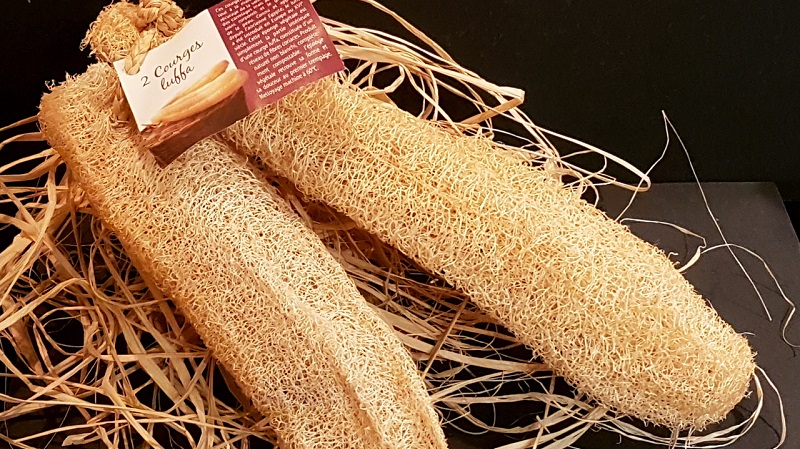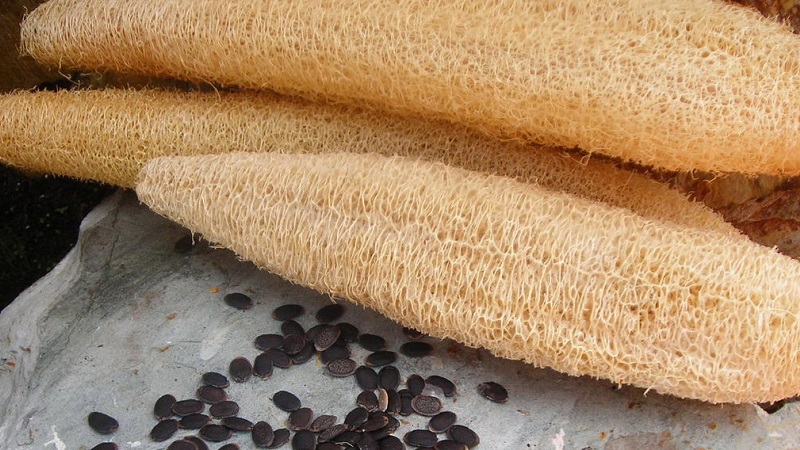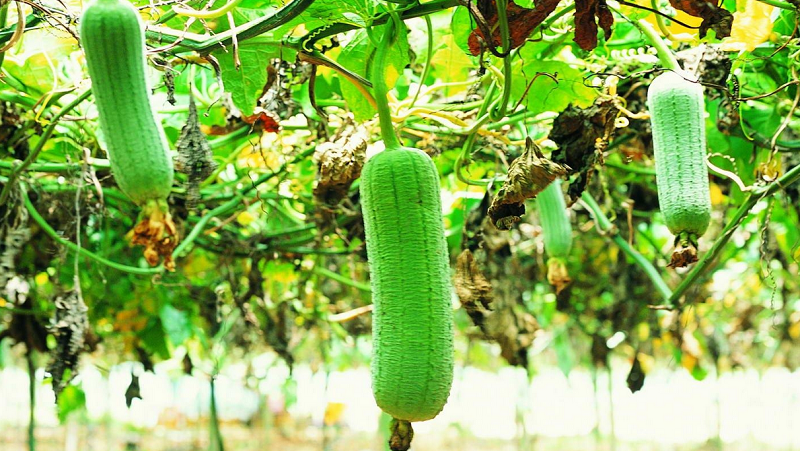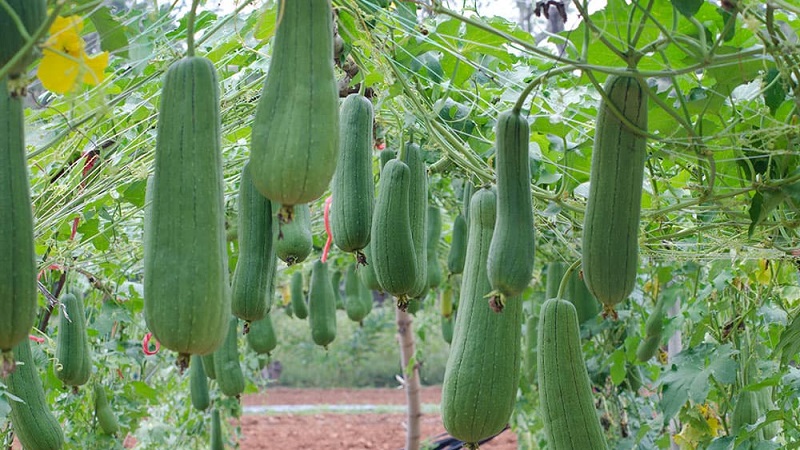The most unusual type of pumpkin "Luffa": what it is and how to make a useful natural loofah out of it
The unusual pumpkin luffa (also known as the Egyptian luffa) is rarely found in summer cottages. But just one bush of this plant will provide the whole family with natural hypoallergenic washcloths for a whole year.
In addition, luffa is a decorative liana, perfect for vertical gardening. Today we'll talk about this amazing plant and how to grow and make a loofah with your own hands.
The content of the article
Loofah gourd
Despite the fact that the culture is considered a loofah, the vegetable is widely used in Southeast Asia in the preparation of a wide variety of dishes.
Unripe fruits are delicate in taste and rich in vitamins B, K, E, C, as well as micro- and macroelements. An unusual vegetable vitaminizes the body and adds variety to the diet.
Description and characteristics
What it is - pumpkin luffa? It is a herbaceous annual plant native to the tropical regions of Asia and Africa. At home, the fruits grow up to 1.5 meters in length.
During the flowering period, vines are decorated with large flowers with a delicate aroma. The fruit (or pumpkin) is shaped like a squash. Inside, ripe pumpkins are white, springy, pleasant to the touch, with many seeds.
Luffa is widely grown on an industrial scale as an industrial crop. It serves as a source of natural fibers. Industrial oil is obtained from plant seeds.
In addition, pumpkin fibers are used in the manufacture of thermal insulation materials, filters for diesel engines, various seals, and sponges for wagon wheels.
Interesting fact. In the USA, luff fibers were used in the manufacture of helmets for soldiers. Such helmets had good sound-absorbing properties.
In our country, cylindrical and sharp-ribbed loofah are mainly cultivated.
In the cylindrical variety of the culture, the pumpkin grows up to 60 cm long. Sharp-ribbed varieties have small fruits - 30-35 cm in length. In temperate climates, the sharply ribbed variety grows best.

Applying loofah pumpkin
The bastard gourd is not only a valuable technical plant, but also a wonderful decoration for any garden. A spectacular culture will decorate a gazebo, wall or fence. Luffa blooms magnificently from July to September, delighting the eye with large white and yellow flowers.
In addition to decorative purposes, the culture is used to make natural washcloths, prepare unusual and healthy dishes, and even in the treatment of certain diseases.
Washcloth making
Loofah washcloths were seen by everyone. But not everyone knows how and from what they are made.
In stores, bath accessories made of artificial materials are increasingly found. Environmentally friendly, natural sponges massage and cleanse the skin well, improve blood circulation and are durable at the same time.
Luffa sponges prepared for the future serve more than one year.
In cooking
Young, unripe pumpkins are eaten, while the fibers in them are not yet coarse. The vegetable is mainly used for stewing and making soups. Luffa pulp is bitter, giving the dishes a spicy and unusual taste.
This vegetable is especially popular in Thailand and China. Local chefs use many pumpkin recipes.Luffa is stuffed, fried, stewed, porridge is made from it, and even added to pilaf.
In medicine
African shamans use seed, juice and luffa pulp for medicinal purposes. The vegetable is used for conjunctivitis, as well as an anti-inflammatory and antipyretic agent.
In folk medicine, infusion of fruits is used for chronic diseases of the nose and paranasal sinuses.
However, in Russia, bastard gourd is not included in the list of medicinal plants.
In cosmetology
The juice from the stems of the plant is used as a lotion for facial skin. In Japan, it is found in cosmetics such as lip balms.

Types of luffa
The culture is represented by a large variety of varieties and varieties.
However, only two types of this interesting plant are of interest to gardeners: cylindrical (luffa cylindrica) with black seeds and sharp ribbed luffa with white seeds (luffa acutangula).
The other several dozen species give such small fruits that it is pointless to grow them.
The cylindrical washcloth is cultivated to produce a natural washcloth. Cylindrical pumpkins are similar to squash. Ripe fruits are composed entirely of tough fibers.
The fruits of the sharp-ribbed luffa are mainly used for food. Small unripe pumpkins are used to prepare a variety of dishes.
Growing loofah from seeds
Interest in the cultivation of loofah is growing along with the growing popularity of environmentally friendly materials. Luff fibers are appreciated by designers and are used in the manufacture of screens and lamps.
Everyone can grow a culture from seeds. However, it should be borne in mind that this is a southern, heat-loving plant. Luffa is best suited for seedling growing from seeds.
The plant agrotechnics is the same as for other types of pumpkin seeds. Seedlings are grown in peat containers or cardboard glasses. The seeds are buried 4-5 cm, the soil is well moistened. Seedlings appear in a week. Seeds are sown a month before planting in open ground.
The prepared seed material shows the best germination. Before planting, the seeds are wrapped in a damp cloth and kept in a warm place for several days. Before sowing, the seeds are dried.
For landing, choose a sunny place protected from cold winds. The recommended predecessors are legumes. Luffa grows poorly in heavy acidic soil, in the shade and in arid places.
The site for planting a loofah pumpkin is prepared in the fall. They dug the garden bed, apply fertilizers, wood ash, humus.
If the culture is grown to obtain large sponge fruits, the number of ovaries on the bush is reduced to 3-5 pieces, the rest are removed.

Outdoor cultivation
Seedlings are planted in open ground after the threat of frost has passed. Luffa cannot stand the cold.
A distance of at least 1 meter is maintained between plants. Luffa whips in open ground grow 5-6 meters long.
The vine is planted along the fence, next to the gazebo or wall. A reliable support is prepared in advance so as not to damage the root system later.
Attention! When growing luffy lianas in a spread, pumpkins grow irregularly shaped and are damaged by fungal diseases.
It is not recommended to use trees as a support, as branches injure delicate ovaries.
Growing in a greenhouse
In central Russia, thermophilic loofah grows well in greenhouses and hotbeds.
If the structure is heated and the night temperature does not drop below 15 ° C, the seeds are sown immediately in the greenhouse. The plant does not tolerate transplants.
If the temperature in the greenhouse is not high enough, the seedlings are grown indoors and then transplanted into the greenhouse. For seedlings, it is preferable to use peat pots.
Water the culture abundantly, especially during the period of growing greenery. At the end of the season, watering is reduced to speed up fruit ripening.
The crop is harvested when the temperature at night drops below + 10 ° C. Remove all pumpkins, including unripe ones, so that they do not rot. If you shake a ripe fruit, you can hear the rustle of seeds inside.
Unripe loofahs are removed together with the stalk and ripened in a dry, warm place.

Luffy sponge making instructions
The beneficial effect of the Luffa sponge on the body is to stimulate blood flow and exfoliate dead cells. Massage with such a washcloth relaxes and relieves stress.
Step-by-step instructions for making a scrubber at home:
- We harvest fruits before the onset of cold weather.
- Dry the pumpkins in a warm and well-ventilated place. If the rustling of seeds is heard when shaking, the fruit is ready.
- Soak the fruits in boiling water for a few minutes and remove the crust (see photo).
- Cut off the pumpkins at both ends and remove the pulp and seeds.
- We wash the sponge frame several times in soapy water.
- Dry the mesh "skeleton" in the sun.
The washcloths are now ready to use. For convenience, sponges are given different shapes and handles are sewn on.

How to use and care for such a washcloth correctly
Before each use, a luff sponge is poured over with boiling water or soaked in hot water. This softens the washcloth.
Caring for your pumpkin loofah is simple. After application, the sponge is washed and dried. Subject to these simple rules, the sponge lasts for several months.
Tips & Tricks
When cultivating crops for the purpose of eating, they strictly monitor the timing of harvesting. Overexposed pumpkins become tough and inedible.
When growing sponge fruits, special attention is paid to the application of fertilizers. Enhanced plant nutrition and the removal of excess ovaries allows you to grow large fruits up to 60 cm in length.
From ripe fruits, hard washcloths are obtained, from unripe ones - softer.
Important! The variety is selected depending on the purpose of the fruit. When growing luffa as a vegetable crop, they choose varieties with small, delicate pumpkins. For technical purposes - with large fruits.
During the period of filling and ripening, the pumpkins should hang freely, without touching anything. Even from minor damage, the fruits quickly rot.

Read also:
Why pumpkin is useful for type 1 and type 2 diabetes.
How to detect pumpkin diseases in time, effectively cure them and save your harvest.
Conclusion
Luffa pumpkin is a healthy vegetable, the unusual fruits of which are used for food and as a material for making loofahs. In addition, the luffy liana is a beautiful ornamental plant that can decorate any summer cottage. In the south of Russia, the thermophilic luffa is grown in open ground, in Siberia - in greenhouses and hotbeds.